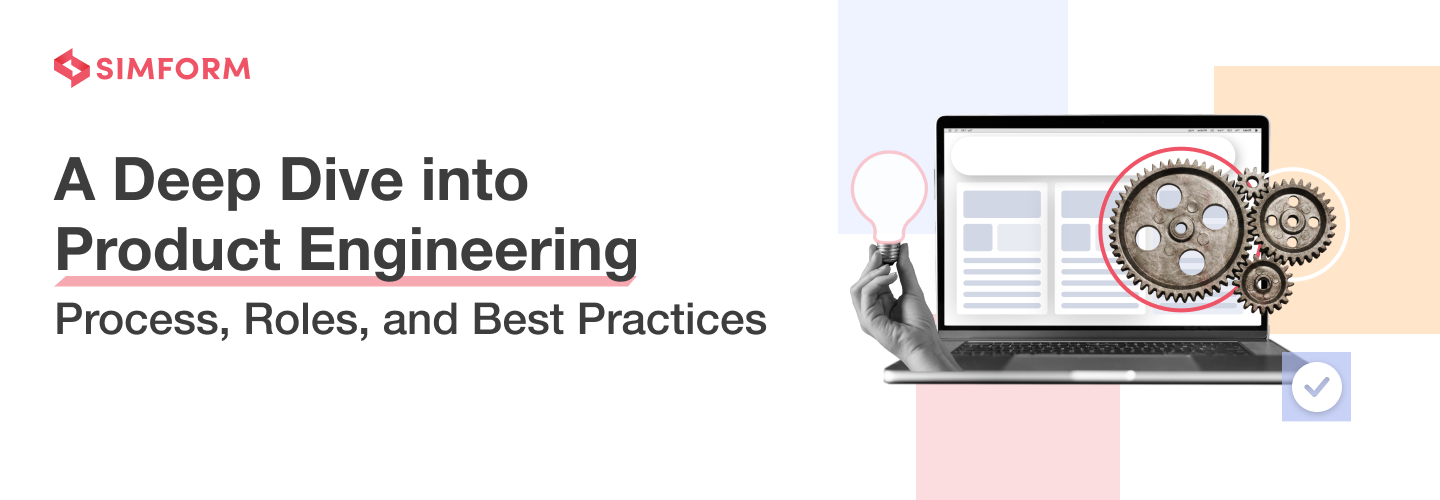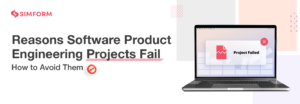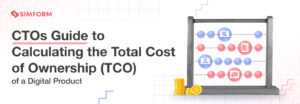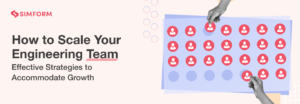A Deep Dive into Product Engineering: Process, Roles, and Best Practices
Every business needs a product; without it, it’s difficult to sustain.
Product engineering helps develop those functional products from ideas. It provides a framework for software development, and offers a competitive edge to businesses through innovations like building a chatbot like “ChatGPT” for your business and integrating it into existing applications.
Product engineering helps define the development process, key roles, and responsibilities and thus understanding it is crucial.
Let’s dive in and explore the fascinating world of product engineering!
What is product engineering?
Product engineering is a process of applying engineering principles, design thinking, and project management to improve user experience, software quality and enable businesses to deploy high-performance systems.
Product engineering provides key benefits of cost-effectiveness, quality improvement, and enhanced security. It includes several processes designed to offer a granular insight into product development.
Additionally, product engineering provides a roadmap for an efficient software development lifecycle (SDLC).
Product engineering process
The product engineering process has several stages, from conceptualization to launch and deployment. Each stage differs from organization to organization based on specific business requirements.
#1. Product discovery
Product discovery is a phase where you research different aspects of software, understand the gaps in the market, and discover the need for a product. You can conduct surveys to understand market demands.
Such surveys also allow you to analyze whether the product is a market fit. You must segment the market per product niche and research specific customer demands. Here are some of the approaches you can take for market research,
- One-on-one interviews- Conduct interviews with potential customers and industry experts to understand the pain points and challenges faced by customers.
- Online surveys-Use the internet to conduct surveys and ask customers about their expectations of your product. This will give you a broader perspective on the market and help gauge the level of interest in your product.
- Focus groups- Build focused groups that test your product and provide feedback on the gaps in user experience.
- Competitor analysis- Observe competitors and analyze their products to identify the gaps in the market and understand what makes your product unique.
- Price-to-value comparison-Compare products in the market, their pricing, and yours to understand how much value your product offers.
Based on your analysis, you will be able to determine the feasibility of the product. Once you have checked the feasibility of the product, it’s time to plan the development. This will include design requirements, production roadmap, and resource and process planning.
#2. Ideation and planning
Product ideation uses insights from the discovery stage to create a roadmap outlining the features, functionalities, and processes for product development. For example, if you are developing an eCommerce application, you must ideate features that improve the shopping experience.
The ideation and planning phase also includes consideration of factors like,
- Scalability-Plan for accommodating growing user base during development
- Security-Ideate security policies and ensure better compliance
- Target audience- Identify the target customer and design features that address their pain points.
- Cost– Consider the budget for developing the product and optimizing it.
Moreover, to build the product, you must plan for development resources, design requirements, tools, and infrastructure.
Based on the product development plan, create a roadmap that will include,
- What resources will you need to develop the product?
- How will you develop the product? (Processes required)
- What will be the product design and architecture?
- What type of tests will you need for the product testing?
- What are the environments in which we will deploy the product?
Once the roadmap is ready, the next stage is to design the product.
#3. Product design
Designing your product requires profoundly understanding your target customers and carefully considering feasibility, functionality, and performance requirements. An effective way to product design is the ”design thinking” approach.
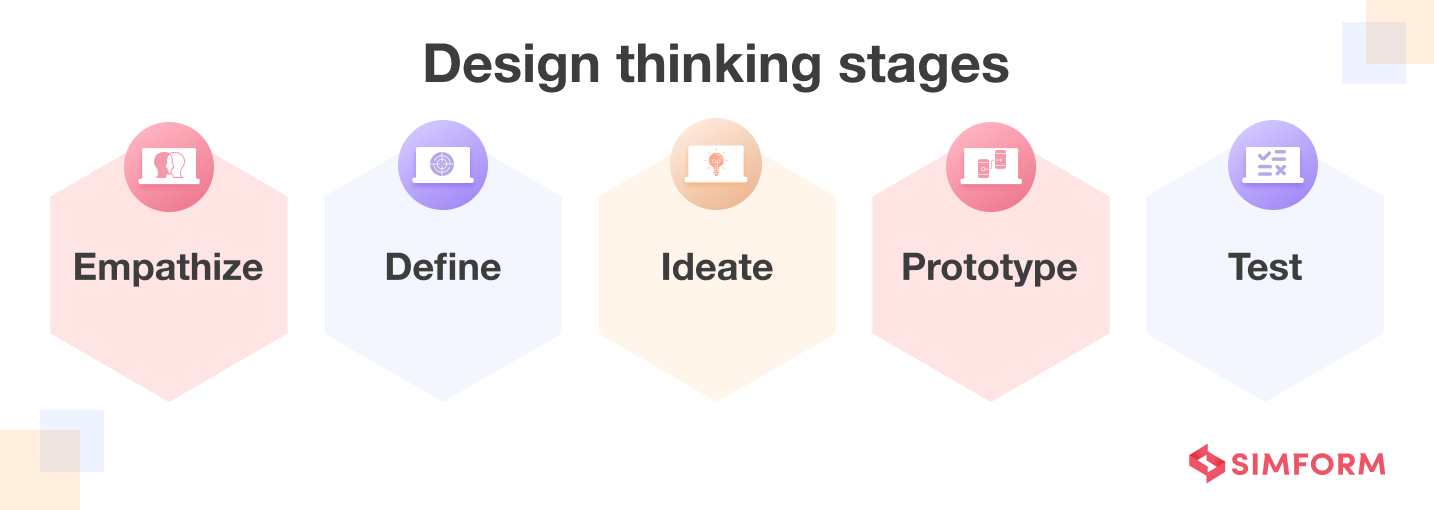
The design thinking approach has five stages,
- Empathize with your target customers and understand their needs, pain points, and goals.
- Define the core problem your product will solve based on customer pain points.
- Ideate solutions that can solve the defined problem
- Prototype, create low-fidelity prototypes to test and refine your idea
- Test your prototypes to gain insights into design requirements.
Design thinking helps you create a comprehensive product design and test it for feasibility. However, design architecture is another crucial aspect of product design that determines how different elements of your software will interact.
It provides structure to different elements and processes that form the core of your software. For example, the microservice architecture allows you to leverage independent services communicating through APIs.
Once your design architecture is in place, you can develop your software product.
#4. Product development
Product development is a broader term encompassing everything from ideation to the product’s final launch.
This section focuses on the development stage of product engineering, which starts with creating a design wireframe of the product. Stakeholders and users provide feedback on the wireframe, and based on the design architecture and feedback, you can create a minimum viable product (MVP) with minimal required features..
MVP offers several benefits, particularly when using an iterative development approach. These include,
- Increased business focus and clarity
- Customer-centric product design
- Improved feedback integration
- Reduced errors and performance bottlenecks
- Ability to refine products with each iteration
MVP testing and feedback integration are critical to enhancing product development, and testing mechanisms should be in place before deployment to ensure a bug-free experience.
#5. Product testing
Product testing is a stage where your software is tested, and results are shared with the developers to remove errors. The testing phase requires planning to identify the types of tests to be conducted, resources needed, and quality assurance requirements.
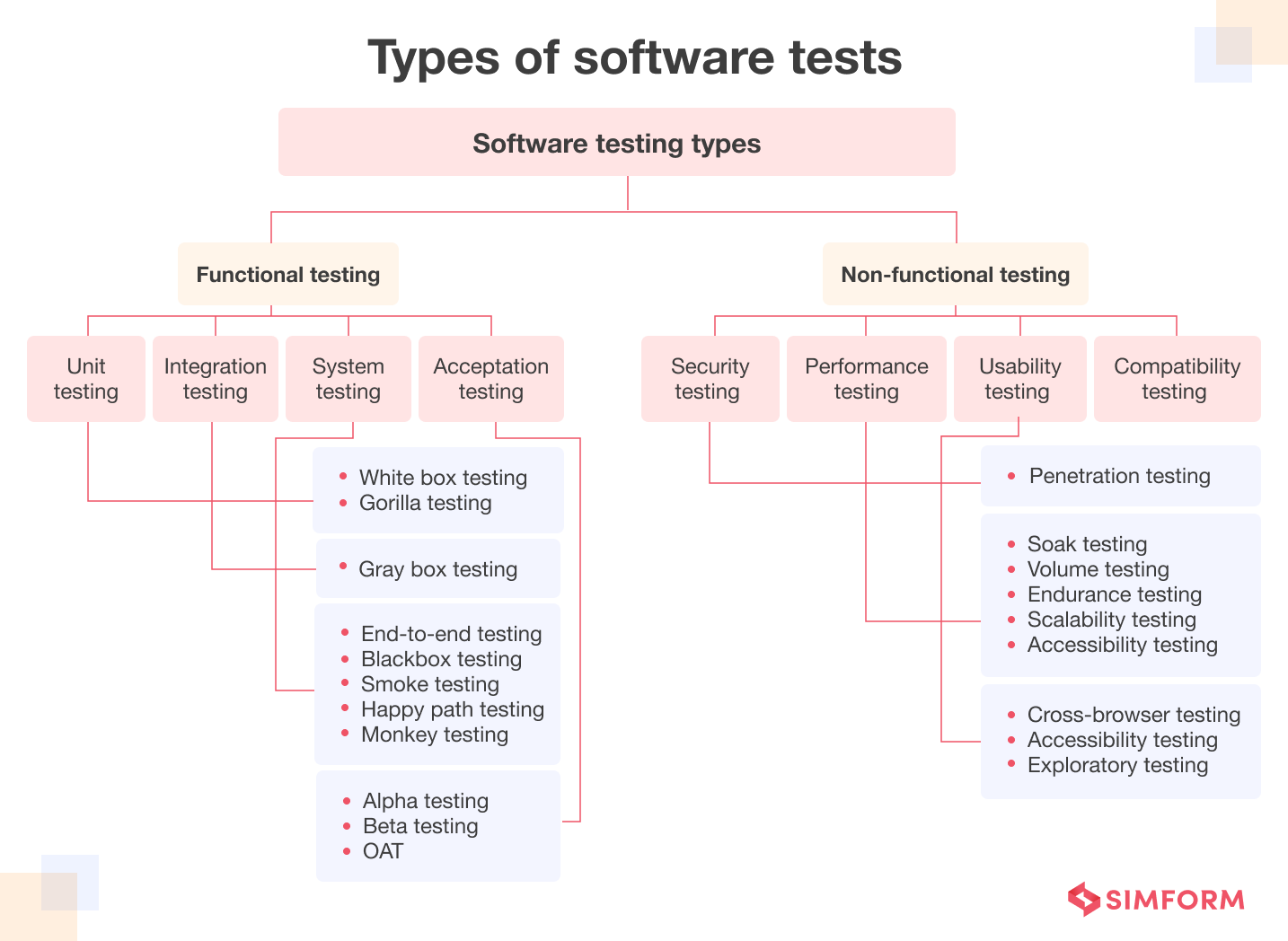
Software product testing begins by identifying multiple test types:
- Unit testing tests each component of the products as an individual unit in two ways: “White box testing,” where the source code or internal structure code is visible to the tester, and “Black box testing,” where the source code is hidden from the testers.
- Integration testing determines how different software modules work together and whether they communicate as expected.
- System testing verifies whether the application meets all specified requirements in different scenarios.
- Acceptance testing is a test to check whether the software meets customer expectations.
- Regression testing ensures that changes to the software do not break the application due to backward compatibility issues by performing functional and non-functional tests across previous software versions.
- Performance testing evaluates the software’s performance under different conditions, such as higher loads, limited system resources, etc.
- Security testing ensures that the software is secure from unauthorized access and that sensitive data is protected. It can include vulnerability assessments, penetration testing, and other security-related tests.
- Usability testing ensures that software is user-friendly and meets the end user’s needs. It can involve user surveys, user interface testing, and feedback sessions.
- Exploratory testing tests the software without predefined test cases or scenarios by exploring the system and attempting to find bugs or issues that other types of testing may have missed.
#6. Deployment and maintenance
After product testing, the deployment stage becomes crucial. Configuring the deployment platforms and ensuring the product meets customer expectations is necessary.
Higher deployment efficiency is one of the key benefits of product engineering, as it provides a framework for deploying products across environments and ensuring high performance.
The product engineering process completes its cycle with the maintenance stage, where you must monitor the performance and pre-defined metrics.
Monitoring and logging key events while the user interacts with the product helps enhance observability, which is crucial for better maintenance. Defining roles and responsibilities at each product engineering stage is also essential.
Roles and responsibilities of a product engineer
Product engineering is a process, and the product engineer is the processor! A product engineer connects the production and development teams to build efficient operations. They help organizations develop reliable and resilient products with process efficiency at each stage of software development.
Who is a product engineer?
A product engineer takes ownership of designing, developing, and implementing engineering principles to deliver products that meet customer demands with a high focus on user experience and customer satisfaction. A clearly defined role for a product engineer ensures efficient product delivery.
What do product engineers do?
A product engineer has multiple responsibilities, from creating a design roadmap to development planning and execution.
Product engineers’ role in designing
Product engineers create a design roadmap that includes
- Design architecture,
- Process of designing
- Validation hierarchy,
- Approval standards,
- Post-approval execution plan
Due to their customer-centric approach, product engineers ensure that design aligns with user expectations and the organization’s goals.
Product engineers’ role in software development
Product engineers stress the importance of quality and functionality through an efficient process. They are involved in development planning, process workflow creation, and project execution.
So, a product engineer,
- Defines key processes in software development
- Applies optimal frameworks for enhanced product performance
- Adopts an iterative approach with agile methodologies
- Develops MVP and test prototypes to improve deliverable quality
- Standardizes the development process across teams when implementing microservices
- Implements software engineering principles for highly reliable product development
The software development phase needs the implementation of different best practices and approaches. An experienced product engineer enables organizations to deliver highly resilient products by implementing suitable engineering approaches.
Product engineers’ role in software delivery
Software delivery involves defining requirements, designing to specifications, and developing and deploying the product. One of the critical aspects of software delivery is implementing continuous improvement in product development and delivery.
Product engineers ensure enhanced software delivery by,
- Gathering customer requirements and feedback, conducting market research and data analysis
- Creating wireframes, mockups, and prototypes of product design as per requirements
- Collaborating with cross-functional teams embracing DevOps culture
- Implementing CI/CD pipeline for continuous improvement
- Ensuring error-free performance through optimized monitoring and logging
Skillset of product engineers
To be an effective communicator and collaborator, a product engineer needs to possess a specific set of skills that enable them to,
- Communicate effectively
- Build relationships
- Work collaboratively
These skills include,
- Ability to explain complex technical concepts in simple language.
- Capability to build relationships, manage conflict, and facilitate effective communication among team members.
- Think creatively, and develop innovative solutions to complex problems.
- Manage projects effectively, including developing project plans, setting milestones, and tracking progress.
- Have a strong background in engineering, mathematics, and science.
- Know the latest market trends, processes, new approaches and design techniques.
Product engineering techniques and tools
Product engineering is essential to ensure software quality, and implementing its principles can be far more efficient with specific techniques and tools.
Several techniques can help in this process, such as prototyping, user experience design, software development life cycle (SDLC) optimization, and agile methodology.
Product engineering best practices
1. Leverage agile methodologies for rapid product development.
In the IT market, the timing of the product is crucial. Agile is an excellent product engineering technique if you want to get your product in the market fast without compromising quality.
The agile methodology enables organizations to make quick changes during product development and use an iterative process to enhance software delivery.
Implementing product engineering principles and leveraging essential techniques like agile methodology or optimizing SDLC requires reliable tools.
2. Use prototyping to ensure reduced cost and higher quality.
Prototyping involves creating smaller versions of products to ensure that the final product meets customers’ expectations.
Benefits of prototyping include
- Improving the understanding of product design across teams
- Ensuring the development of optimized products
- Reducing the errors and time needed to rectify them
3. Design the product for enhanced UX.
User experience (UX) design aims to create an easy-to-use, functional, and interactive product. This technique involves gathering data from customer-facing teams to create a design that addresses user problems and pain points.
Steps to follow for enhancing user experience,
- Conduct thorough research on target users’ needs, preferences, and pain points.
- Keep your design consistent and in alignment with the user’s preferences
- Add more whitespace for visual hierarchy, contrast, and balance to the overall UI look
- Use coherent color scheme, typography, iconography, and layout for the unity of elements
- Optimize micro-interactions, animations, and loading indicators for a better experience
- Integrate feedback from users on the design aspects
4. Optimize stages of SDLC.
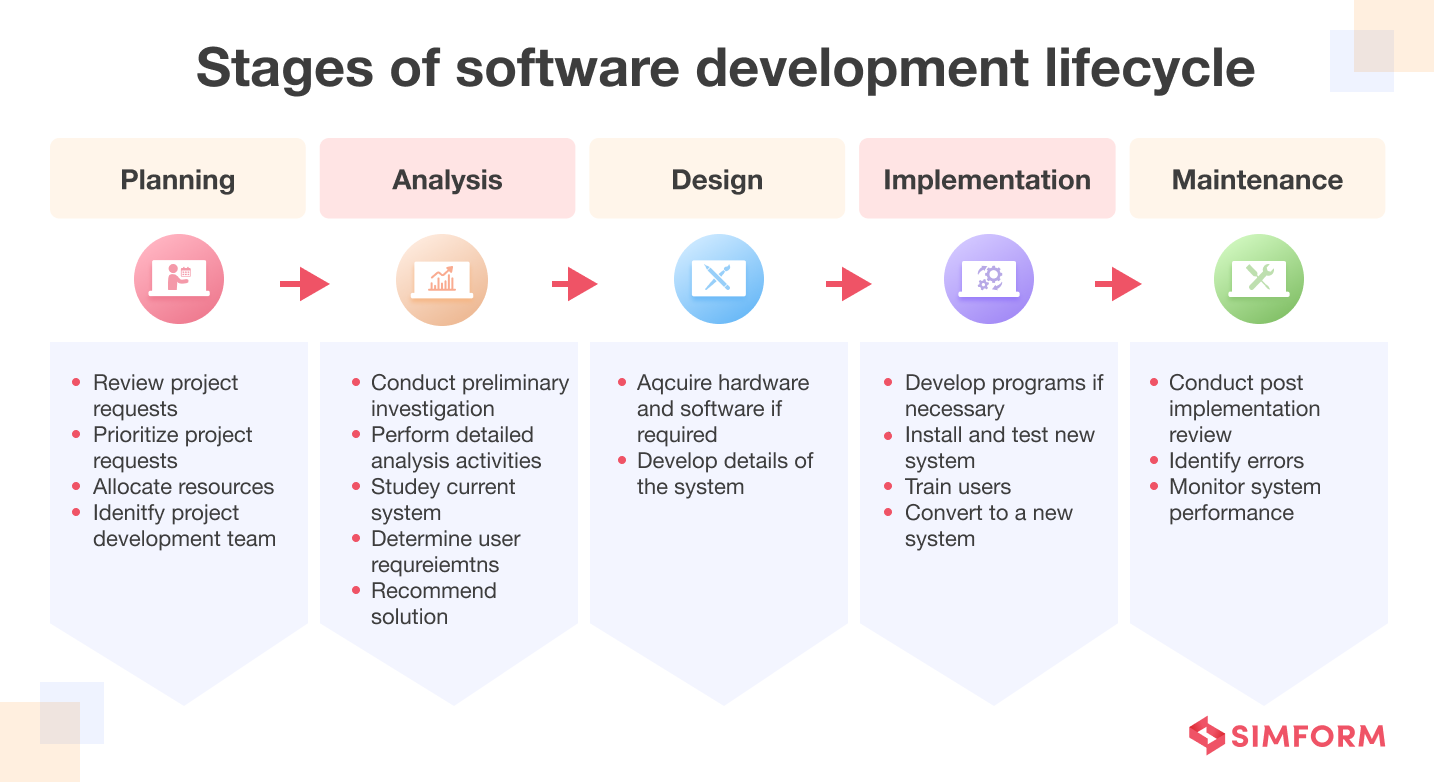
Software development life cycles (SDLCs) have several stages planning, design, development, testing, and maintenance. Optimizing SDLC stages requires implementing product engineering principles. Here’s how to implement product engineering at each phase of SDLC,
- Planning stage-Optimize planning by gathering data through enhanced data analytics from the market and customers to understand the product requirements.
- Analysis stage-Analyze product requirements and create a wireframe design.
- Design stage- Use the wireframe and information from the planning stage to design your product.
- Implementation phase – Implement the design using optimal development approaches such as agile methodologies, embracing DevOps, and implementing CI/CD.
- Maintenance stage-Monitor system performance and fine-tune software delivery
Top product engineering tools
#1. GitHub
GitHub is a web-based repository and hosting service. You can use it to share, collaborate, and contribute to open-source projects. It offers several features and tools for version control, code review, and issue tracking.
Pros
- Git-based version control system
- Excellent code collaboration and sharing features
- Robust issue tracking and project management tools
- Integration with various third-party tools and services
Cons
- Limited free features compared to other similar platforms
- Steep learning curve for beginners
- It can be expensive for enterprise organizations
#2. Jira
Jira is a product engineering tool that you can use for project management, root cause analysis, and bug tracking. It enables cross-functional teams to collaborate and share critical project information easily.
Jira provides three indicators for monitoring software issues: status, transition, and resolution. A status indicates where the issue is within a workflow, the transition showcases the action taken to resolve it, and finally, the resolution tag indicates the completion of the task.
Pros
- Flexible and customizable workflow management
- Excellent issue-tracking and bug-reporting features
- Integration with other development tools and services
- Agile methodology support with features such as Scrum and Kanban boards
Cons
- It can be complex and overwhelming for small teams or beginners
- Limited customization options for non-technical users
- It can be expensive for larger teams or enterprise organizations
#3. Git
Git solves the problem of maintaining product versions. You can use a distributed version control system to manage versions in product development projects. It helps manage and track changes to source code.
Pros
- Fast and efficient version control system
- Supports distributed development workflows
- Excellent branching and merging capabilities
- Command-line interface and integration with other tools
Cons
- Steep learning curve for beginners
- Requires technical knowledge to use effectively
- Limited support for large binary files
#4. IntelliJIDEA
IntelliJ IDEA is an integrated development environment (IDE) for Java, Kotlin, and other programming languages. It provides features such as code navigation, debugging, and refactoring. You can use it to create code for your software products and debug and refactor applications.
Pros
- Excellent code completion and error detection
- Robust debugging and testing tools
- Integration with various frameworks and tools
- Supports multiple programming languages
Cons
- Expensive compared to other IDEs
- It can be resource-intensive and slow on older hardware
- The steep learning curve for beginners
#5. Jenkins
Jenkins is an open-source automation server that enables organizations to implement CI/CD pipelines. It provides features such as build automation, testing, and deployment for your software projects.
This tool is beneficial for microservices-based projects, where updating services individually is necessary, as Jenkins offers better isolation and automated CI/CD pipeline implementation.
Pros
- Flexible and customizable automation workflows
- Integration with various development tools and services
- Supports multiple programming languages
- Open-source with a large community for support
Cons
- Requires technical knowledge to use effectively
- Resource-intensive and slow on older hardware
- Steep learning curve for beginners
#6. SonarQube
SonarQube is an open-source code quality assurance tool that helps you find errors and bugs automatically before deploying them. It combines dynamic and static analysis tools to provide a comprehensive report on code quality.
Pros
- Optimizes application performance through reduced bugs, and errors
- Helps detect vulnerabilities, initially securing the applications
- Improves the code quality of apps
- Reduces cost of maintenance
Cons
- Does not provide automatic pull requests for fixes needed
- Does not offer enough insights into issues with project libraries
- Can create false positives, making maintenance tedious
#7. ESLint
ESLint is a linter of ECMAScript and a static code analysis tool that helps analyze the code quality to find bugs. This tool allows you to find problems with Javascript code through static analysis. ESLint is designed to be extensible and has several custom rules. These rules make it easy to understand the root cause of any error message.
Pros
- Highly flexible with the facility of changing rules as per specific requirements
- Provides tons of plugins, making it extensible
- Efficient in finding errors due to a set of several rules
- Supports ES6, and custom reporters
Cons
- Configuration requirements make it a little tricky
- Takes more time to find the issue and fix i
#7. JUnit
JUnit is a unit testing tool that you can use to test Java code. It enables you to find errors and ensure the expected output from the code execution. JUnit also provides a test runner to find methods marked as tests in the source code and execute those code blocks
Pros
- Provides text-based command lines or AWT-based or Swing-based graphical test mechanisms
- Offers annotations for testing purposes
- Allows you to write test code
- Pre-built test runners to test running application
Cons
- Not suitable for higher-level testing
- Group testing is not possible with JUnit
- Can’t create HTML test reports for different use cases
#8. Selenium
Selenium is an open-source automation testing framework that helps validate web apps across different browsers. You can use programming languages like Python, C#, Java, and others to write custom Selenium tests. However, it is essential to understand that Selenium is not just a tool but a suite of tools that help automate testing. Selenium is a suite of testing tools such as,
- Selenium Integrated Development Environment (IDE)
- Selenium Remote Control (RC)
- WebDriver
- Selenium Grid
Pros
- Allows modification of the base framework due to open-source origins
- Cross-programming language compatibility makes it easy to use
- Easier integration of third-party tools and services
- Supports all the web browsers which are popular like Chrome, Firefox, Opera, etc.
Cons
- Higher initial cost as you need to make one-time payments
- Requires integrations for advanced functionality
Parallel testing with Selenium can get tricky based on project requirements
Conclusion
Product engineering principles are essential to businesses looking for optimal user experience. It helps streamline processes and define roles and responsibilities to make customer-centric products.
This, in turn, requires elaborate planning, analysis, monitoring, and applying several best practices. Partnering with product engineers can help organizations employ the best techniques and tools.
Just like this guide on AWS data engineering tools that help enhance product development. Reach out to discuss your needs!

